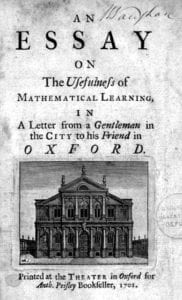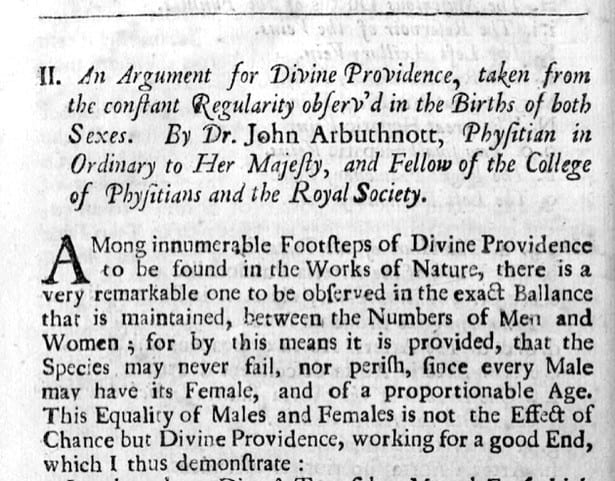JMS Pearce
Hull, England, United Kingdom

Fig 1. Portrait of Arbuthnot on reprint of John Bull
In the light of recent British parliamentary chaos, by chance I discovered this irresistible quotation:
“All political parties die at last of swallowing their own lies”
-John Arbuthnot
At a time when in most westernized countries physicians and many others are disenchanted by politicians’ self-aggrandizement and expansionist policies, this little aphorism anticipates much modern opinion. But who was John Arbuthnot? (1667- 1735) (Fig 1)
Inquiry reveals not just a physician much praised in his day, but a satirist and mathematician, who in the words of Samuel Johnson was: “a scholar with great brilliancy of wit; a wit, who, in the crowd of life, retained and discovered a noble ardour of religious zeal.”
Born in Inverbervie, Kincardine, Scotland, son of Alexander Arbuthnot, an Episcopal clergyman, John attended Marischal College, Aberdeen.1 In 1694, he entered University College, Oxford as a fellow-commoner, where he studied medicine privately. In 1696, he qualified in Medicine at St. Andrews. He began to practice in Doncaster, Yorkshire, but was not successful. He moved to London to lodge with Mr. William Pate, a scholarly woollen draper. He made his living by teaching mathematics and was acclaimed for his early Essay on the Usefulness of Mathematical Learning (1701) (Fig 2.). His learning and facetious yet congenial conversation furthered his medical practice and reputation.
By chance, he was in Epsom when Prince George of Denmark, husband of Queen Anne, became suddenly ill. Arbuthnot was called and provided medical care with such success that he was appointed his physician. He was then made physician to Queen Anne in 1705 and remained so until her death. He had lodging at St. James’s Palace. Dean Swift called him “the Queen’s favourite physician.” He was elected FRS in 1704 and received the MD at Cambridge on 16 April 1705, and on 12 December 1707 was elected honorary Fellow of the College of Physicians of Edinburgh, and Fellow of the Royal College of Physicians London in April 1710.
Arbuthnot was a scholar with a gentle, kindly manner and sharp wit. He was a founder member of The Scriblerus Club, a group of literate Tory wits, who included: Alexander Pope, Dean Jonathan Swift, John Gay, and Thomas Parnell. (Scribler was the contemporary term of contempt for a talentless writer.) With Swift, he was the chief contributor to Pope’s Memoirs of Martinus Scriblerus (1741), which ridiculed bad literature and false learning; its theme underwrote parts of Swift’s Gulliver’s Travels. Like his friend Swift, Arbuthnot was admired as a political satirist.

Fig 2. An Essay on the Usefulness of Mathematical Learning
His first publication in 1692 was On the Laws of Chance, or a Method of Calculation of the hazards of game . . . In similar vein he translated Christiaan Huygens’ 1657 treatise on mathematical probability, Ratiociniis in Aleae Ludo, adding material of his own. An Essay on the Usefulness of Mathematical Learning, (1701)2 considerably furthered his reputation.
His most important scientific work was a paper in 1710: An argument for divine providence, taken from the constant regularity observ’d in the births of both sexes (Fig 3). In it he showed that between 1629 and 1710 the annual number of male christenings had been consistently slightly higher than the number of female christenings: “Art not Chance, that governs . . . Provident Nature brings forth more Males [who are at most risk] than Females.”3 This paper was the topic of much statistical and philosophical debate.
His work was varied. He taught mathematics and worked as a physician and for the government’s customs department. The Queen appointed him in 1713 as physician at the Chelsea Hospital. In the Royal College of Physicians, he was elected Second Censor in 1723 and delivered the prized Harveian Oration in 1727. An early medical work appeared in 1731: An essay concerning the nature of aliments, and the choice of them, according to the different constitutions of human bodies. A second edition added ‘Practical Rules of Diet’. An advocate of public health and aware of the effects of poor quality air in inducing infections and fevers, he published An Essay Concerning the Effects of Air on Human Bodies (1732/3).
In the Royal Society between 1704-35, Arbuthnot was vigorous in mathematical dialogues, especially in a committee to resolve the dispute concerning priority for the invention of calculus in the Commercium epistolicum, an attack on Leibniz by Isaac Newton.
His friendship with the leading scholars, writers, and statesmen4 provided well-earned patronage.5 In 1727 his Law is a Bottom-less Pit: five tracts in two parts as the “History of John Bull” in the Miscellanies in Prose and Verse,i established the character who was forever the icon of the typical Englishman (Fig 1). He used Bull to inveigh against the Whigs and the Court machinations of the Marlboroughs, the Church of England, and Dissenters. John Bull was “. . . an honest plain-dealing Fellow, Cholerick, Bold and of a very inconstant Temper . . . ruddy and plump . . . quick and understood his business very well, but no man was more careless, in looking into his Accounts or more cheated by Partners, Apprentices or Servants . . .”
Lord Orrery in his Life of Swift characterized Arbuthnot:
Although he was celebrated for his wit and learning, there was an excellence in his character more amiable than all his other qualifications: I mean the goodness of his heart . . . He laughs as jovially as an attendant upon Bacchus, but continues as sober and considerate as a disciple of Socrates.6

Similarly, Dr. Samuel Johnson noted in his Life of Pope:
Arbuthnot was a man of great comprehension, skilful in his profession, versed in the sciences, acquainted with ancient literature, and able to animate his mass of knowledge by a bright and active imagination; a scholar with great brilliancy of wit. . . .
Having suffered from obesity and asthma for many years he retired in 1734 to Hampstead, but soon moved to Cork Street, Burlington Gardens. A letter to Pope in July 1734 related: “A recovery in my case, and at my age, is impossible; the kindest wish of my friends is Euthanasia.” He died on 27 February 1735, and was buried at St. James’s Church, Piccadilly. He left a son and two daughters. A fine portrait by Jervas is on the staircase at the Royal College of Physicians, London. Munk’s roll records: 7
Few men have been more esteemed, none have left behind a character for learning, or for the most elevated social, moral and religious virtues. The language of eulogy has been well nigh exhausted upon him . . .
When the poet Alexander Pope was ill, Arbuthnot attended him. Pope dedicated an Epistle to Dr. Arbuthnot soon after Arbuthnot’s death. It is one of the few places where Pope mentions his own ill health and he praises Arburthnot for helping him maintain “This long disease, my life.” Some of his remaining writings are held at Arbuthnot’s works, Project Gutenberg.8
Endnotes
- From a manuscript found in the cabinet of Sir Humphry Polesworth in 1712
References
- Ross A. Arbuthnot John. Dictionary of National Biography. London: Oxford University Press, 2004.
- Westfall, Richard S. Galileo Project http://galileo.rice.edu/Catalog/NewFiles/arbuthnt.html
- Arbuthnot J. An argument for divine providence, taken from the constant regularity observed in the births of both sexes. Philosophical Transactions Royal Society 1710 (27, no. 328),
- “John Arbuthnot” Encyclopædia Britannica https://www.britannica.com/biography/John-Arbuthnot
- Aitken GA. The Life and Works of John Arbuthnot, (Oxford, 1892).
- Chambers, Robert. A Biographical Dictionary of Eminent Scotsmen … Glasgow, Blackie & Son 1835. Volume 1, pp. 45-57.
- Munk’s Roll. Lives of the Fellows of the Royal College of Physicians of London, Vol II (1701 – 1800). London: Published by the College. 1984. Pp. 27-32.
- Project Gutenberg http://www.gutenberg.org/ebooks/search/?query=arbuthnot (Arbuthnot)
JMS PEARCE, MD, FRCP (London), is a retired neurologist and author with a particular interest in the history of science and medicine.

Leave a Reply